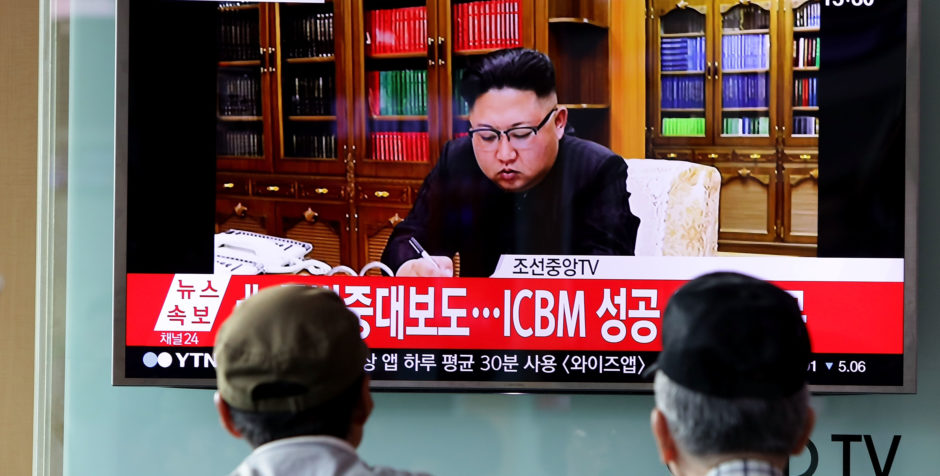The Conundrum that is North Korea
On Tuesday, August 15th, North Korea’s Kim Jong Un stepped away from the strategic ledge that would not have ended well for him: He decided not to attack the U.S. Territory of Guam and modulated his rhetoric. While Kim is reactionary and uncivilized by any standard, he is neither stupid nor suicidal. The North Korean dictator faced the very real threat of a devastating attack by the United States. Unlike previous U.S. Presidents, Mr. Kim was not certain whether President Donald J. Trump would actually order such an attack.
The threat of an attack by the United States, combined with a unanimous vote by the United Nations Security Council imposing new sanctions—the harshest to date—on North Korea, have certainly motivated Kim to change his strategic stance and to save face. His instincts for self-preservation—something he has exhibited dramatically as he grabbed the reins of power in North Korea in December of 2011 and killed his political enemies, including members of his own family—kicked in. Accordingly, he backed down. This was a wise decision.
However, there was more in play than simple self-preservation. What else prompted Kim Jong Un to back away from his reckless rhetoric? What is the end-state he seeks? What is the ultimate goal?
First, Kim intends to keep the nuclear bombs he already possesses. Depending on which intelligence report you read, North Korea has somewhere between six and sixteen nuclear weapons. Additionally, Kim wants to increase North Korea’s military power, including its ballistic missile capabilities. And it is clear that North Korea’s strategy of moderating its tone, and even giving the world a bit of false hope that it might negotiate, has been a winning strategy for the North Korean government for some time.
Beginning in 1994 with the Clinton Administration’s outreach to North Korea and then the famous Six Party Talks, the Kims have used their threaten and then negotiate strategy with great success. During the Bush Administration talks included the United States, South Korea, China, Japan, Russia and North Korea. In 2005, North Korea reached an agreement with the other countries to suspend its nuclear program in return for diplomatic rewards and energy assistance. Negotiations collapsed after the last round of talks in 2008, with North Korea declaring the deal void after refusing inspections to verify compliance. This is North Korea’s modus operandi: Promise to talk, pretend to eliminate its weapons, bargain for food, fuel and financial aid, tone down the belligerence a bit. In response, the world will either ease the sanctions or, as Russia, China and Iran have done in the past, ignore them. Meanwhile, North Korea continues its research and development and marches quietly and steadily towards a reliable Intercontinental Ballistic Missile (ICBM) with nuclear capability. This approach has worked for North Korea; it is how they developed the nuclear weapons they now possess.
Kim’s recent actions have the makings of a strategic diversion. While his retreat from threats to Guam is most certainly a win for the United States and the Trump Administration in the short-run, it does not solve the larger problem. The articulated goals of Secretary of State Tillerson and Secretary of Defense Mattis in their joint editorial in The Wall Street Journal is not to negotiate so that North Korea might keep its current nuclear and ICBM capabilities and simply agree to not do any further development. The stated goal is the denuclearization of the Korean Peninsula.
As long as North Korea possesses nuclear weapons and ballistic missiles, the threat is real and the danger remains, with the potential for it to expand in ways that are difficult to predict and even more difficult to control. It is likely that at some point, North Korea will sell its ballistic missile technology to Iran, along with its nuclear technology, if not the nuclear weapon itself. If this happens, the second and third order effects of allowing North Korea to retain these weapons will come back to haunt us and to make the world unimaginably less safe.
This does not mean that war with North Korea is the only option. It does mean that the United States must lead the entire community of nations in enforcing the recent sanctions and keeping the pressure on the hermit kingdom to give up their nuclear weapons.
In the long run, and it is the long run in which we find ourselves, North Korea must give up its ability to strike other nations with a nuclear weapon. To achieve this goal demands vigilance and unequivocal resolve on the part of the United States and the United Nations. It means that Russia and China must continue to enforce the sanctions against North Korea. Short of war, the only way to solve this problem is for the world to continue to isolate North Korea diplomatically, financially and in matters of trade until Kim surrenders his weapons of mass destruction and joins the community of nations. It is a long shot but, as history has shown, any pause in this course of action is a pause that North Korea will use to its advantage; it will continue to develop nuclear weapons and the missiles with which to deliver them.
Standing down from a threat to attack Guam is a good development. It does not change our long-term strategic calculus regarding the Korean Peninsula. Now is not the time to bargain with North Korea or even to agree to negotiate. The safety and security of the United States and, indeed, the world is at stake. Some things are non-negotiable. A North Korea with nuclear-tipped ICBMs is one of those.
